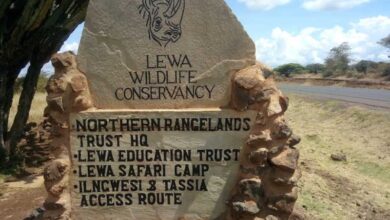Here is a list of endangered animal species in Kenya. Only the Democratic Republic of the Congo has more reported mammal species than Kenya, which ranks tenth in the world and second in Africa. Several of these mammal species must be endemic given their sheer abundance. A species is considered to be endemic if its habitat is restricted to a particular country, island, or area under study.
Native or indigenous species are different from endemism in that they can also be found elsewhere. owing to changes in their limited habitats, mainly owing to hunting and habitat loss, endemic species face a high danger of extinction. Kenya must protect and sustain its unique biodiversity because its the main facet that attracts tourists.

Beautiful creatures with delicately striped black and white hides are gravy zebras. The Gravy zebra, the most endangered of the three zebra species (Common, Gravy, and Mountain), is also the tallest. They feature broad, rounded ears, a dark muzzle, and thin stripes on their body. Predation and overgrazing have put the animals in danger, and the attractive hides draw thieves. Samburu National Reserve, Meru National Park, Marsabit National Reserve, and Lewa Wildlife Conservancy are all places where one can locate Grevy zebras.
2. Black Rhinos

The most threatened big mammals in Kenya are black rhinos. The large, protruding horns of rhinos, which may reach a length of five feet, draw poachers. Because they are browsers, black rhinos vary from white rhinos in that they have pointed upper lips. The lip of the white rhino is square. Additionally, whereas white rhino calves trot ahead, black rhino calves follow their mother. The most seriously endangered big mammal in Kenya is the black rhino. Consequently, a Rhino Ark has a sanctuary for rhinos. You may arrange a safari with Divulge Adventures and visit Nairobi National Park, Ol Pejeta Wildlife Conservancy, and Lewa Wildlife Conservancy to observe black rhinos in Kenya.
3. Mountain Bongo

Instinctively recognizable by their stunning reddish-chestnut coat with black markings, noticeable white stripes, and long spiraling horns, bongos are among the most distinctive, colorful, and magnificent antelopes on the globe. The tropical rainforests of central and west Africa are their natural home. The mountain bongo, a highly endangered subspecies, does, however, live in the highland forests of central Kenya. The bongos from the mountains are bigger and have a slightly more vivid color than those from the West.
In the past, there were many Mountain Bongo in the forested areas of Mount Kenya, the Aberdares, Mau, Cherengani Hills, and Mount Elgon. Their numbers have drastically decreased over the past 40 years, and they are currently restricted to small groups in isolated woodland sections of Mount Kenya and the Aberdares. On the IUCN Red List, mountain bongos are categorized as Critically Endangered (CR). A number of factors have contributed to the reduction, but the primary ones include habitat loss, hunting, and diseases spread by cattle. Hunters have traditionally treasured the Mountain Bongo as a prized trophy due to its beauty and relative scarcity. Their population in zoos is significantly higher than their wild counterpart.
4. Hirola Antelope

The Hirola is an antelope native to northeast Kenya and southwest Somalia that is among the rarest and most endangered in the world. The Hirola is slim and has a sandy-colored coat. As men get older, they have a grayer tint. They have long legs, a small neck, and an extended face. a white chevron or line passes from one eye to the other across the forehead, giving the Hirola a bespectacled appearance.
The hot, arid plains habitat of the Hirolas is characterized by short grass and dry acacia bushes. They chew the rough grass with their huge molars. The Hirola can tolerate dry spells for extended periods of time by storing extra fat in its body. Hirolas typically feed during dawn and evening, sparing them from needless energy-draining activities.
In addition to being outside of any recognized or gazetted national parks, their range, a constrained area of around 7,600 km2 along the border between Kenya and Somalia, makes them more vulnerable, particularly to hunting and habitat encroachment. The species, which was once widespread throughout East Africa, has experienced a severe decline in the past 30 years, with numbers falling drastically from about 14,000 in the 1970s to an estimated less than 500 today.
5. Tana River Mangabey

A medium-sized monkey with a long tail and a yellowish-brown coat is known as a Tana River Mangabey. It has a prominent crest on its crown, and its white eyelids contrast sharply with its jet-black face. The species, which is restricted to a fragmented riverine woodland mosaic along the lower Tana River in Kenya’s coastal region, is critically endangered. Due to the river’s meandering route and varying water levels, these woodlands are naturally fragmented.
For their survival, mangabeys are very reliant on the forest. Their food consists largely of plants from the forest’s canopy or subcanopy. Over time, the forest has been deteriorated by unsustainable forest clearing (an estimated 50% of the original forest has been lost in the last 20 years) and resource extraction (trees have been felled for canoe construction, wild honey has been collected, and palm fronds have been used for thatching and mats). As a result, the species have been declining quickly.
One of the top 25 most endangered primate species worldwide is the Tana River mangabey. There are currently between 1000 and 1200 individuals thought to be living in the wild. An efficient conservation strategy is urgently required since habitat destruction is the primary factor contributing to the Tana River Mangabey decrease. Previous conservation attempts were unsuccessful. The issue of forest removal and the gathering of forest products needs to be better managed if there is any chance of protecting the habitat of this critically endangered primate and forestalling its otherwise imminent extinction.
6. Roan Antelope

Only the African buffalo and eland are larger than the roan antelope, one of Africa’s largest bovids. The Roan Antelope has a grey or brown coat, long, tasselled ears, and a clown-like black-and-white facemask that is darker on the males than the females. The horns of both sexes curve backward, however the females’ are shorter. A male bull leads the groups of around twenty people that they dwell in. Due to the Roan’s elimination from some of its former habitat, it is almost certain to go extinct. Due to poaching, their habitat has been destroyed and the majority of them have been killed. At the moment, Ruma National Park in Kenya is home to these stunning antelopes.




